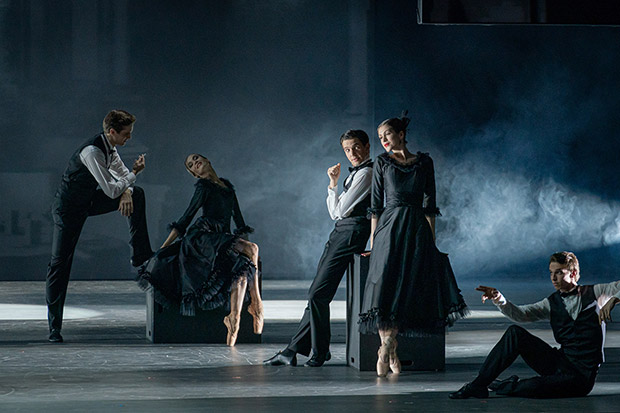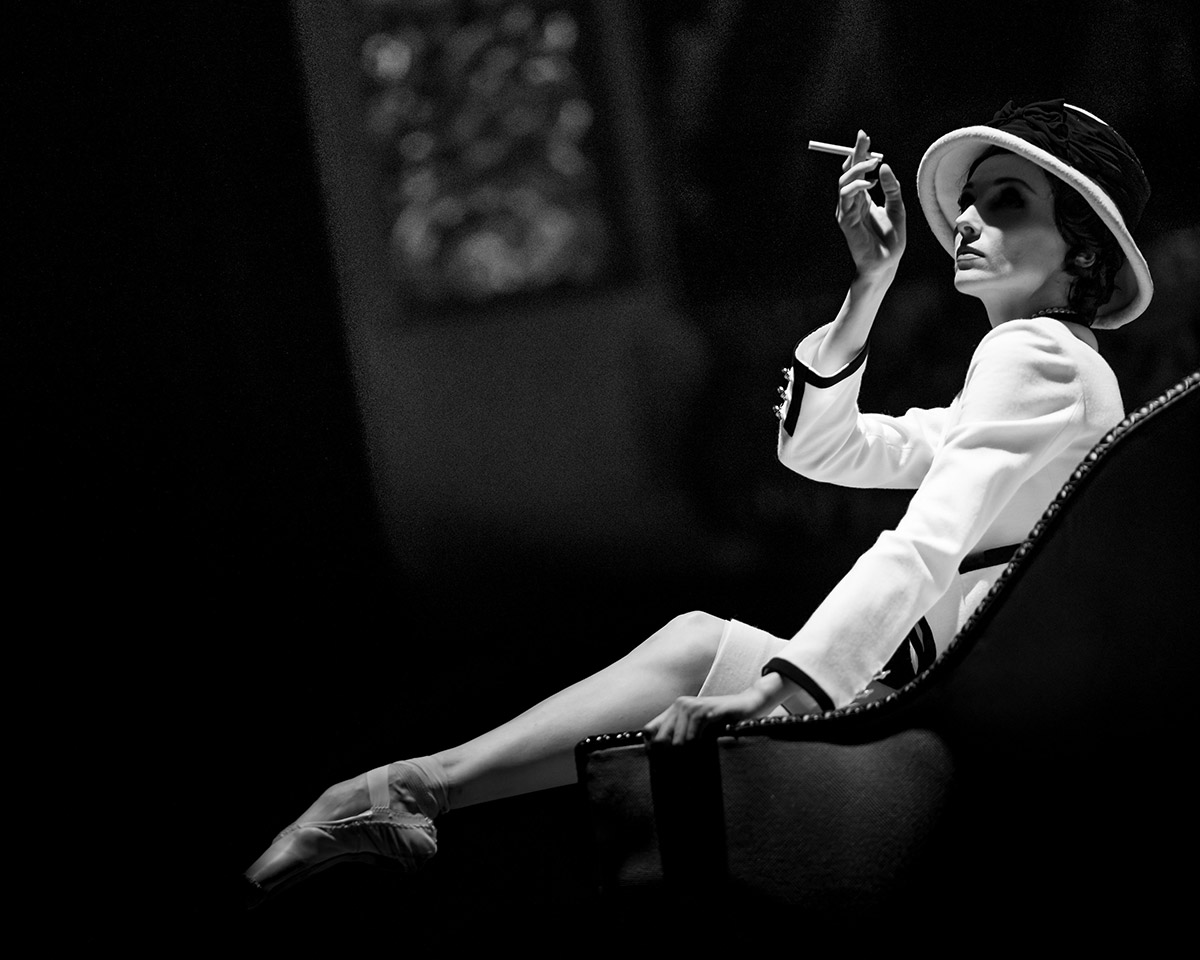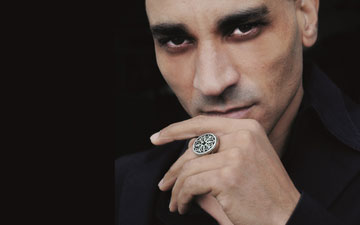
© Jack Devant. (Click image for larger version)
Svetlana Zakharova
Modanse: Gabrielle Chanel, Come un Respiro
★★★✰✰
London, Coliseum
3 December 2019
www.svetlana-zakharova.com
londoncoliseum.org
Stunning images of Bolshoi ballerina Svetlana Zakharova dressed as Coco Chanel (costumes by the Chanel Creative Studio) whetted the appetite for the London Premiere of her latest how, Modanse. Though the souvenir programme had yet more spectacular photographs of Chanel and Zakharova, prices for the booklet as well as the seats were off-putting. This is a luxury project, launched in June this year with a gala at the Bolshoi theatre.
The one-act ballet, Gabrielle Chanel, took up the second half of the programme. The collaboration between the choreographer, Yuri Possokhov, and composer, Ilya Demutsky, is the same as for Nureyev, premiered controversially in Moscow two years ago. According to accounts of that biographical ballet, the structure of the Chanel tribute is similar: a flashback, projections of films and photographs, disparate scenes from the subject’s life and an assurance at the end that the legend will live on.
Zakharova, lean and svelte, gets to wear a succession of Chanel outfits once Coco’s career as a couturière is launched. Seated in an armchair, dressed in a bouclé suit and matching hat, she recalls her youth as a cabaret performer, where she acquired her Coco nickname. She is taken up by a wealthy playboy, Etienne Balsan (Bolshoi principal Mikhail Lobukhin), but soon ditches him for an English polo player, Arthur Capel (Jacopo Tissi). Dressed in white, Tissi is a handsome foil for Zakharova’s love-struck Gabrielle. Tissi, 24, left La Scala Ballet for the Bolshoi in 2017, where he is now a leading soloist.
As ‘Boy’ Capel, he dances two pas de deux with Zakharova during the course of the ballet – the first of seduction, the second of tormented emotions as he leaves her during wartime. These duets have the most rewarding choreography in a production that otherwise prioritises style over substance. The drawback to a format of dissociated scenes rather than a continuous narrative is the abrupt changes of focus (and costumes). No sooner is Chanel head over heels in love than she opens a fashionable salon, convincing Edwardian socialites that less is more.

© Jack Devant. (Click image for larger version)
The next moment she is involved withDiaghilev’s Ballets Russes. Possokhov has fun referring to Balanchine’s Apollon Musagète and Nijinska’s Les Biches and Le Train bleu. Demutsky’s score avoids quoting the composers for the ballets, so the choreography remains a jokey parody. Chanel’s contribution was to provide the sportif costumes for Le Train bleu, set on the Riviera, which she helped make fashionable during the summer as well as the winter. The ballet’s premiere was in 1924, by which time Capel had died in a car crash.
So the following scenes must be flashbacks, as Zakharova expresses her distress as Capel’s imminent departure in 1919. All in black, she clings to him, legs flailing from side to side to tempestuous music. He calms her, laying his head touchingly on her shoulder as he leans into her resistant body. It’s a fine pas de deux of conflicting feelings, ending with her cast down, alone in a spotlight.
A projected quotation in French, one of many during the ballet, speaks of ‘anxiety penetrating the body’ as she dances a distraught solo, doubled over, arms clutching at the air. Black and white video shows a winding mountain road, while on stage, men with black boxes simulate a crash. Cut abruptly to the next scene, in which Chanel decides to create a new perfume. We have to accept that she is overcoming her grief by continuing to work.
Denis Savin, Bolshoi leading soloist, enjoys himself as the camp master perfumer Ernest Beaux, offering Chanel flacons of fragrances until she selects Number Five (in 1921). Her fashion house flourishes, testified by a musical comedy parade of chic outfits to uplifting music. We are nearing the end of the ballet, steering clear of the Second World War and Chanel’s involvement with the Nazis. She lived on until 1971, the latter part of her life less scintillating than her early career.
Zakharova embodies Chanel’s chic allure in white trousers and black jersey top with strings of pearls. A projected collage of photographs of the real Gabrielle from youth to maturity summons up memories as Zakharova stalks the stage on pointe, still kicking her legs up high before she sinks poignantly back into her armchair. Possokhov hasn’t given her a distinctive choreographic language as she ages: the costumes provide the chronology, outer shells for Chanel’s inner life. Zakharova took her first curtain calls in character, standing alone and aloof, arms folded across her heart. Her Chanel is a star, albeit a remote one, unknowable.

© Jack Devant. (Click image for larger version)
In the first half of the programme, Zakharova is surrounded by a constellation of Bolshoi soloists, principals and corps members in Mauro Bigonzetti’s Come un Respiro (Like A Breath). He uses Jiri Kylian’s device of setting contorted modern choreography to baroque music – here, Handel’s clavier studies, performed in a recording by an uncredited pianist. Why not a pianist in person, given the attention paid to all the other elements in the Modanse production? The recording was so over-amplified, as was Demutsky’s commissioned score for Gabrielle Chanel, that the music was painfully distorted.
Come un Respiro, first performed by Aterballetto in 2009, has been given new costumes by Helena de Medeiros. The women’s fantastical tutus appear inspired by the tail feathers of flightless birds; the men are more prosaic in patterned leggings and bare torsos. Bigonzetti’s choreography aspires to be quirky, relying on classical technique while resorting to hip wriggling, foot flexing and groin grinding, with ungainly lifts displaying bums in the air – all this to music for gigues, sarabandes and gavottes. In between solos and duets, the dancers keeping going in silence to prove how unconventional they are.
There’s a standout duet for two men, brothers Alexei and Anton Gaynutdinov, entwined like twin souls or competing as rivals. In all-male groupings, it can be hard to tell whether the men are parodying butch athletes working out gymnastically. Tissi shines as a beacon of purity in an Apollonian solo. Zakharova in black ruffles resembles a beautiful female spider, mesmerising a potential partner in an elaborate courtship ritual. She is enabled to make full use of her hyperextended limbs as she allows herself to be manoeuvred into extreme positions, legs reaching skywards.
While it’s diverting to watch Bolshoi dancers execute the kind of modern ballet the company is not usually invited to perform in London seasons, Bigonzetti’s grotesqueries don’t provide much of a challenge. He has tried to pull the sequences together by starting and ending the ballet with all 15 dancers holding hands in a squirming line, as if united by a thread. Like Possokhov’s scenes from Chanel’s life, it doesn’t cohere convincingly.

















You must be logged in to post a comment.